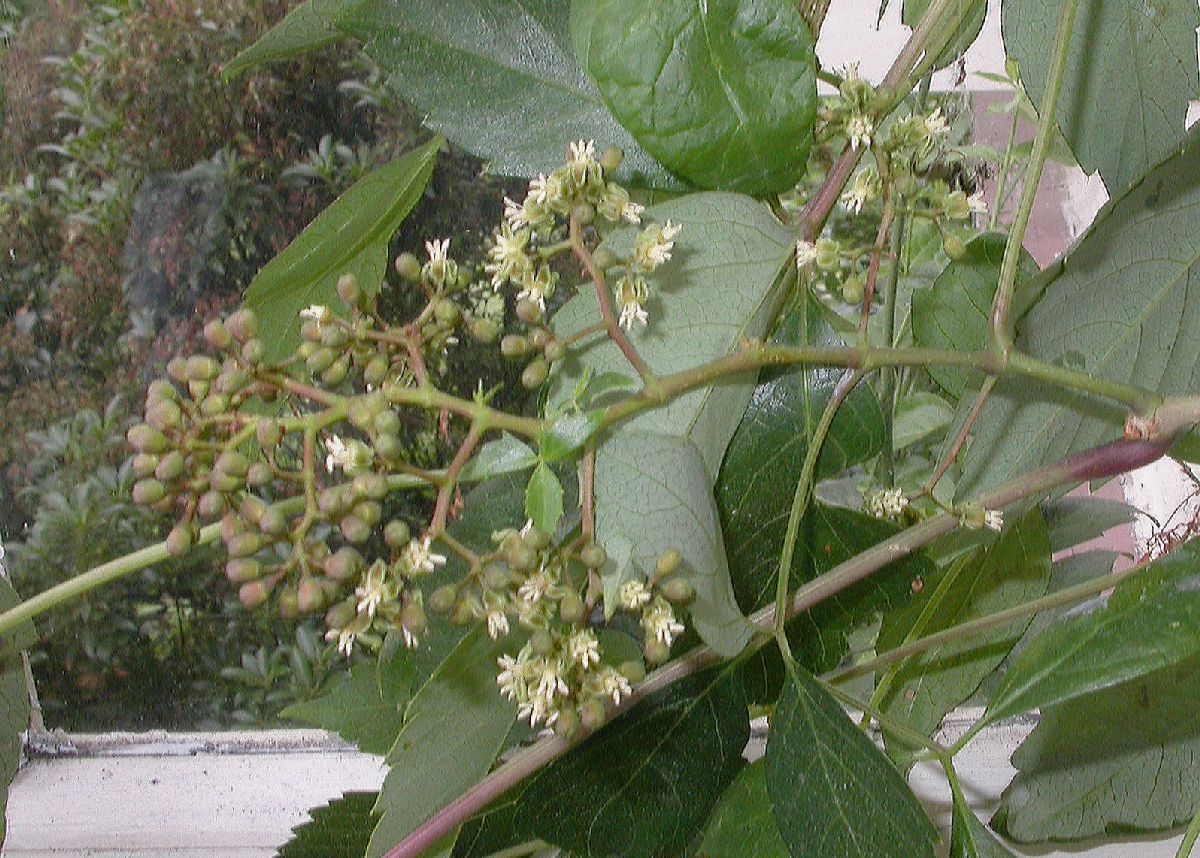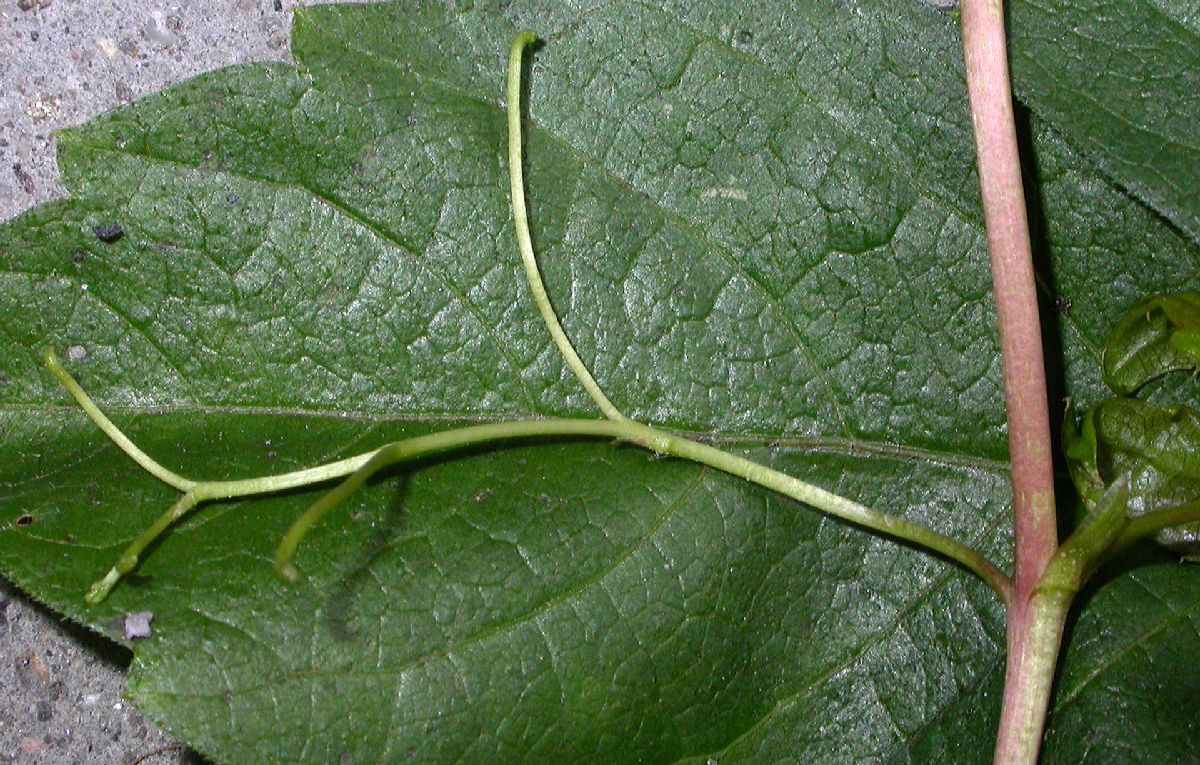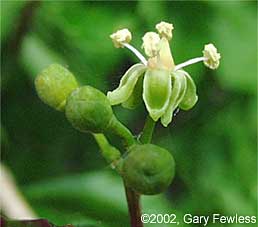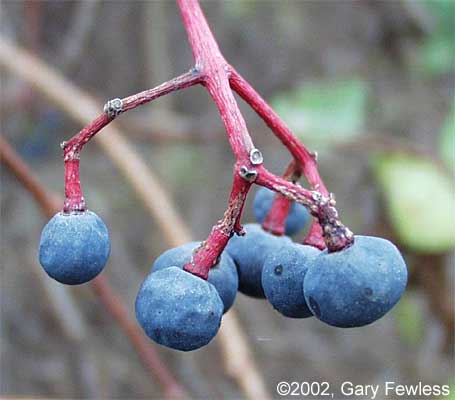 Download PDF
Download PDF
Name: Parthenocissus vitacea (Knerr) Hitchc.
Family: Vitaceae, the Grape Family
Common Names: Woodbine, Thicket Creeper, Grape woodbine, Five-leaved Ivy, and False Virginia Creeper (1,2,6,7,10)
Etymology: Parthenocissus derives its name from the Greek parthenos and kissos, meaning “virgin” and “ivy”, respectively. Vitacea means “vine-like” (6).
Botanical synonyms: Psedera vitacea (Knerr) Greene, Parthenocissus inserta (Kerner) Fritsch (2)
Quick Notable Features:
¬ Alternate, palmately compound leaves
¬ Absence of adhesive disks on tendrils
¬ Leaves are lustrous green on top, pale and slightly pubescent on the bottom
¬ Branches and leaves turn red in the fall
Plant Height: P. vitacea is a low climber, generally only growing a few feet high to scramble over shrubs and rocks (15).
Subspecies/varieties recognized (21):
P. vitacea var. dubia Rehder
P. vitacea var. laciniata (Planch.) Rehder
Most Likely Confused with: P. vitacea is most likely confused with P. quinquefolia or P. tricuspidata. Young specimens might be confused with Toxicodendron radicans.
Habitat Preference: P. vitacea is found in a variety of habitats: rocky outcrops, woodlands, swamps, upland forests, along stream banks, and in thickets (3).
Geographic Distribution in Michigan: P. vitacea is found scattered throughout Michigan all over both peninsulas. The highest concentration of counties with confirmed sightings is in the southeastern Lower Peninsula (3). Because of its confusion with other species of Parthenocissus, the recorded distribution may be less than the true distribution
Known Elevational Distribution: P. vitacea is found at altitudes of less than 1000m (6).
Complete Geographic Distribution: Native to North America, P. vitacea is found in every region except in the Southwest, specifically east of Texas and Oklahoma, south of Virginia and Missouri. Not recorded from Kentucky, West Virginia, Maryland, and Delaware (1,6).
Vegetative Plant Description: P. vitacea is a loosely climbing vine, without adhesive disks on the tendrils. The tendrils have a few branches each. The leaves of P. vitacea are palmately compound, with 5 leaflets attached at a central point. The leaves are thick, lustrous green above and paler below as well as thinly pubescent. The leaflets are generally 5-12cm long, but can be found in a large leaved form in which the leaflets are as much as 2dm long and 1dm wide. The leaflets are strongly toothed (2,3,7,16).
Climbing Mechanism: P. vitacea climbs with branched tendrils that are without adhesive disks. The tendrils are borne opposite the leaves on branching shoots (12).
Flower Description: The inflorescences are in panicles scattered along the branches and are found opposite the leaves. The flowers are small, greenish, and generally perfect but on some vines they are unisexual as well. There are 10-60 flowers per inflorescence (2,7,8,16). Each flower has 5 tepals that are each cup shaped at the tip as they are closed in bud, retaining the cup when open. Five stamens are present, with a single style and stigma (pers. obs. Robyn J. Burnham)
Flowering Time: In Oklahoma, the flowers bloom in late spring or early summer (9).
Pollinator: There were no specific pollinators found.
Fruit Type and Description: The fruit is a drupe (a single-seeded fleshy fruit) that are dark blue and resemble those of Vitis spp. The fruit is 9-12mm wide, globose, and has (1-)4 seeds. The fruits ripen in fall (6,9).
Seed Description: P. vitacea seeds are approx 5mm long, brown, and slightly wrinkly (2).
Dispersal Syndrome: The seeds are dispersed by birds, which eat the fruit (14).
Distinguished by: P. vitacea can be distinguished from P. quinquefolia and P. tricuspidata by the absence of adhesive disks on the tendrils, and the absence of pubescence on the leaflet undersurfaces. It also generally has fewer flowers per panicle than P. quinquefolia. P. tricuspidata generally bears simple palmate leaves, only 3-foliate at the base, as opposed to 5-foliate in P. vitacea (and P. quinquefolia) (5,16).
Other members of the family in Michigan: There are 2 other species of Parthenocissus in Michigan and there are 2 other genera of Vitaceae in Michigan: Ampelopsis (largely cultivated): 1 species, and Vitis: 4 species (1,3).
Ethnobotanical Uses: Iroquois people used P. vitacea as a urinary aid by to ease difficult urination caused by gall. The Navajos used it a ceremonial medicine and used the berries and leaves, to create a remedy for swollen arms or legs. They also used the berries for food. The Jemez people used the berries to create a purple paint for their skin (11,17,18,19).
urination caused by gall. The Navajos used it a ceremonial medicine and used the berries and leaves, to create a remedy for swollen arms or legs. They also used the berries for food. The Jemez people used the berries to create a purple paint for their skin (11,17,18,19).
Phylogenetic Information: Parthenocissus is a Core Eudicot of the Order Vitales within the family Vitaceae, which places it in the basal Rosid clade. The genus has been recently revised, removing the Asian species to a related genus, Yua (13, 20).
Interesting Quotation or Other Interesting Factoid not inserted above: P. vitacea grows at an extremely rapid rate. It is possible to witness growth of the vine at a rate of 1-2 coils per hour depending on the diameter of the support (14).
Literature and websites used:
- USDA, NRCS. 2008. The PLANTS Database, Version 3.1, National Plant Data Center, Baton Rouge, LA 70874-4490 USA. http://plants.usda.gov/ (3/12/09)
- McGregor R.L. 1986. Flora of the Great Plains. Lawrence, Kansas, USA: The University Press of Kansas.
- Voss, E. G. 1985. Michigan Flora Part II: Dicots. Ann Arbor, Michigan, USA: Cranbrook Institute of Science.
- ITIS: Integrated Taxonomic Information System http://www.itis.gov/index.html Retrieved [March 12, 2009], from the Integrated Taxonomic Information System on-line database.
- Barnes, B.V. and W.H. Wagner 1992. Michigan Trees: A guide to the trees of Michigan and the Great Lakes Region. Ann Arbor, MI, USA: The University of Michigan Press.
- Hickman, J. C. 1993. The Jepson Manual. Berkley and Los Angeles, California, USA: University of California Press.
- Gleason, H.A. and A. Cronquist. 1991. Manual of Vascular Plants of the Northeastern United States and Adjacent Canada. Bronx, New York, USA: New York Botanical Garden Press.
- Young, J.A. and C.G. Young. 1992. Seeds of Woody Plants in North America. Portland, OR: Dioscorides Press
- Johnson, F.L. and B.W. Hoagland 1999. Okalahoma Biological Survey (http://www.biosurvey.ou.edu/shrub/pavi5.htm 4/3/2009)
- USDA, ARS, National Genetic Resources Program. Germplasm Resources Information Network – (GRIN) [Online Database]. National Germplasm Resources Laboratory, Beltsville, Maryland. URL: http://www.ars-grin.gov/cgibin/npgs/html/paper.pl?language=en&chapter=scient (3/18/09)
- Herrick, J.W. 1995. Iroquois Medical Botany. Syracuse, New York, USA: The Syracuse University Press
- Millington, William F. 1966. The tendril of Parthenocissus inserta: determination and development. American Journal of Botany 53:74-82
- Solomon, J. 2006. W3TROPICOS VAST nomenclatural database. Missouri Botanical Garden. http://mobot.mobot.org/W3T/Search/vast.html
- Krischan, D. 2001. The vine that twines. Wisconsin Natural Resources Magazine (Online). Last Modified: October 2001. (accessed 5/28/2009) http://dnr.wi.gov/wnrmag/html/stories/2001/oct01/vine.htm
- Menninger, Edwin A. 1970. Flowering Vines of the World: An Encyclopedia of Climbing Plants of the World. New York, USA: Hearthside Press Incorporated.
- Fernald, M. L. 1950. Gray’s Manual of Botany, 8th ed. New York, USA: American Book Company.
- Elmore, Francis H. 1944. Ethnobotany of the Navajo. Sante Fe, NM. School of American Research.
- Vestal, Paul A. 1952. The Ethnobotany of the Ramah Navaho. Papers of the Peabody Museum of American Archaeology and Ethnology 40(4):1-94 (p. 36)
- Cook, Sarah Louise 1930. The Ethnobotany of Jemez Indians. University of New Mexico, M.A. Thesis (p. 26).
- Nie , Z.-L., H. Sun, Z.-D. Chen, Y. Meng, S. R. Manchester, and J. Wen . 2010. Molecular phylogeny and biogeographic diversification of Parthenocissus (Vitaceae) disjunct between Asia and North America. American Journal of Botany 97(8): 1342-1353.
- Tropicos.org. Missouri Botanical Garden. 13 Dec 2012 http://www.tropicos.org/Name/34000194
Image Credits (all used with permission):
1) Image of leaves © Robyn J. Burnham, University of Michigan
2) Image of inflorescence © Dennis Stevenson, retrieved from Plant Systematic website (http://www.plantsystematics.org/taxpage/0/genus/Parthenocissus.html)
3) Close up image of leaf and tendril © Dennis Stevenson, retrieved from Plant Systematic website (http://www.plantsystematics.org/taxpage/0/genus/Parthenocissus.html)
4) Image of flower © Gary Fewless, from the University of Wisconsin, Green Bay Site (http://www.uwgb.edu/BIODIVERSITY/herbarium/shrubs/parvit01.htm)
5) Image of fruit in fall © Gary Fewless, from the University of Wisconsin, Green Bay Site (http://www.uwgb.edu/BIODIVERSITY/herbarium/shrubs/parvit01.htm)
Primary Author: Bradley Sisson with editing and additions from Robyn J. Burnham
© Robyn J. Burnham, University of Michigan
For additional information on Michigan Plant Diversity web pages please contact Robyn J. Burnham via email: rburnham“at”umich.edu